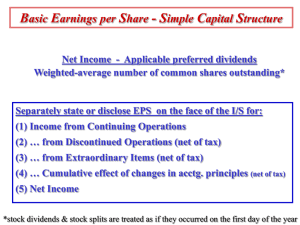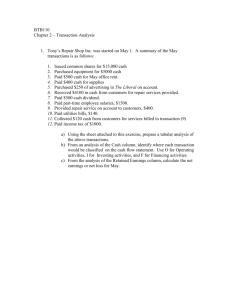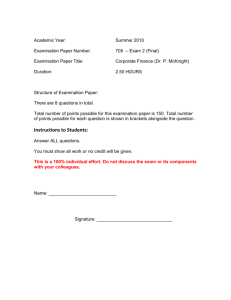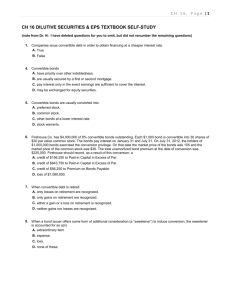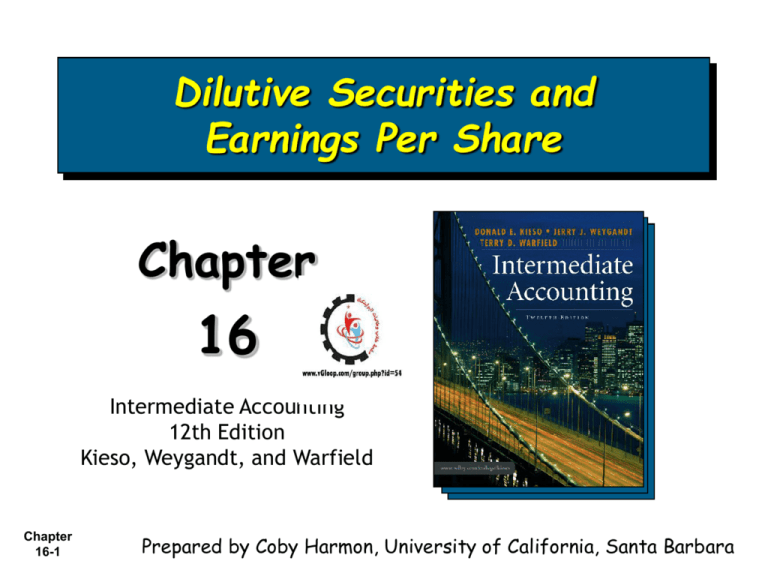
Dilutive Securities and
Earnings Per Share
Chapter
16
Intermediate Accounting
12th Edition
Kieso, Weygandt, and Warfield
Chapter
16-1
Prepared by Coby Harmon, University of California, Santa Barbara
Learning Objectives
1.
Describe the accounting for the issuance, conversion, and
retirement of convertible securities.
2.
Explain the accounting for convertible preferred stock.
3.
Contrast the accounting for stock warrants and for stock
warrants issued with other securities.
4.
Describe the accounting for stock compensation plans
under generally accepted accounting principles.
5.
Discuss the controversy involving stock compensation plans.
6.
Compute earnings per share in a simple capital structure.
7.
Compute earnings per share in a complex capital structure.
Chapter
16-2
Dilutive Securities and Earnings Per Share
Dilutive Securities
and Compensation
Plans
Chapter
16-3
Computing Earnings
Per Share
Debt and equity
Convertible debt
Simple capital
structure
Convertible
preferred stock
Stock warrants
Stock
compensation
plans
Complex capital
structure
Debt and Equity
Should companies report these instruments
as a liability or equity.
Stock Options
Chapter
16-4
Convertible
Securities
Preferred Stock
Accounting for Convertible Debt
Bonds which can be converted into other
corporate securities are called convertible
bonds.
Benefit of a Bond (guaranteed interest)
+
Privilege of Exchanging it for Stock
(at the holder’s option)
Chapter
16-5
LO 1 Describe the accounting for the issuance, conversion,
and retirement of convertible securities.
Accounting for Convertible Debt
Two main reasons corporations issue
convertibles:
Desire to raise equity capital without giving
up more ownership control than necessary.
Obtain common stock financing at cheaper
rates.
Chapter
16-6
LO 1 Describe the accounting for the issuance, conversion,
and retirement of convertible securities.
Accounting for Convertible Debt
At Time of Issuance
Convertible bonds recorded as straight debt
issue, with any discount or premium amortized
over the term of the debt.
Chapter
16-7
LO 1 Describe the accounting for the issuance, conversion,
and retirement of convertible securities.
Accounting for Convertible Debt
BE16-1: Gall Inc. issued $5,000,000 par value, 7%
convertible bonds at 99 for cash. If the bonds had not
included the conversion feature, they would have sold
for 95.
Journal entry at date of issuance:
Cash
Discount on bonds payable
Bonds payable
4,950,000
50,000
5,000,000
($5,000,000 x 99% = $4,950,000)
Chapter
16-8
LO 1 Describe the accounting for the issuance, conversion,
and retirement of convertible securities.
Accounting for Convertible Debt
At Time of Conversion
Companies use the book value method when
converting bonds.
When the debt holder converts the debt to
equity, the issuing company recognizes no gain
or loss upon conversion.
Chapter
16-9
LO 1 Describe the accounting for the issuance, conversion,
and retirement of convertible securities.
Accounting for Convertible Debt
BE16-2: Yuen Corp. has outstanding 1,000, $1,000
bonds, each convertible into 50 shares of $10 par value
common stock. The bonds are converted on December
31, 2008, when the unamortized discount is $30,000 and
the market price of the stock is $21 per share.
Journal entry at conversion:
Bonds payable
1,000,000
Discount on bonds payable
30,000
Common stock (50,000 x $10)
500,000
Additional paid-in capital
Chapter
16-10
470,000
LO 1 Describe the accounting for the issuance, conversion,
and retirement of convertible securities.
Accounting for Convertible Debt
Induced Conversion
Issuer wishes to encourage prompt
conversion.
Issuer offers additional consideration,
called a “sweetener.”
Sweetener is an expense of the period.
Chapter
16-11
LO 1 Describe the accounting for the issuance, conversion,
and retirement of convertible securities.
Accounting for Convertible Debt
BE16-2: Yuen Corp. has outstanding 1,000, $1,000 bonds,
each convertible into 50 shares of $10 par value common
stock. Assume Yuen wanted to reduce its annual interest cost
and agreed to pay the bond holders $70,000 to convert.
Journal entry at conversion:
Bonds payable
1,000,000
Discount on bonds payable
30,000
Common stock (50,000 x $10)
500,000
Additional paid-in capital
470,000
Debt conversion expense
Cash
Chapter
16-12
70,000
70,000
LO 1 Describe the accounting for the issuance, conversion,
and retirement of convertible securities.
Accounting for Convertible Debt
Retirement of Convertible Debt
Recognized same as retiring debt that is not
convertible.
Difference between the acquisition price and
carrying amount should be reported as gain or
loss in the income statement.
Chapter
16-13
LO 1 Describe the accounting for the issuance, conversion,
and retirement of convertible securities.
Convertible Preferred Stock
Convertible preferred stock includes an option
for the holder to convert preferred shares into a
fixed number of common shares.
Convertible preferred stock is considered
part of stockholders’ equity.
No gain or loss recognized when converted.
Use book value method.
Chapter
16-14
LO 2 Explain the accounting for convertible preferred stock.
Convertible Preferred Stock
BE16-3: Gilbert Inc. issued 2,000 shares of $10 par value
common stock upon conversion of 1,000 shares of $50 par
value preferred stock. The preferred stock was originally
issued at $55 per share. The common stock is trading at
$26 per share at the time of conversion.
Journal entry to record conversion:
Preferred stock
Paid-in capital – Preferred stock
Common stock (2,000 x $10 par)
Paid-in capital – Common stock
Chapter
16-15
50,000
5,000
20,000
35,000
LO 2 Explain the accounting for convertible preferred stock.
Stock Warrants
Certificates entitling the holder to acquire
shares of stock at a certain price within a
stated period.
Normally arise:
1. To make a security more attractive
2. As evidence of preemptive right
3. As compensation to employees
Chapter
16-16
LO 3 Contrast the accounting for stock warrants and
for stock warrants issued with other securities.
Stock Warrants
Issued with Other Securities
Detachable Stock Warrants:
Proceeds allocated between the two
securities.
Allocation based on fair market values.
Two methods of allocation:
(1) the proportional method and
(2) the incremental method
Chapter
16-17
LO 3 Contrast the accounting for stock warrants and
for stock warrants issued with other securities.
Stock Warrants
Proportional Method
Determine:
1. value of the bonds without the warrants, and
2. value of the warrants.
The proportional method allocates the proceeds
using the proportion of the two amounts, based on
fair values.
Chapter
16-18
LO 3 Contrast the accounting for stock warrants and
for stock warrants issued with other securities.
Stock Warrants
BE16-4: Margolf Corp. issued 1,000, $1,000 bonds at 101.
Each bond was issued with one detachable stock warrant.
After issuance, the bonds were selling in the market at 98,
and the warrants had a market value of $40. Use the
proportional method to record the issuance of the bonds and
warrants.
Bonds
Warrants
Allocation:
Issue price
Allocation %
Total
Chapter
16-19
Number
Amount
Price
1,000 x $
1,000 x $ 0.98 = $
1,000 x
$
40 =
Total Fair Market Value
$
Bonds
$ 1,010,000
96%
$
970,392
Warrants
$ 1,010,000
4%
$
39,608
Total
980,000
40,000
1,020,000
Bond face value
Allocated FMV
Discount
Percent
96%
4%
100%
$
$
1,000,000
970,392
29,608
LO 3 Contrast the accounting for stock warrants and
for stock warrants issued with other securities.
Stock Warrants
BE16-4: Margolf Corp. issued 1,000, $1,000 bonds at 101.
Each bond was issued with one detachable stock warrant.
After issuance, the bonds were selling in the market at 98,
and the warrants had a market value of $40. Use the
proportional method to record the issuance of the bonds and
warrants.
Cash
Discount on bonds payable
1,010,000
29,608
Bonds payable
Paid-in capital – Stock warrants
Chapter
16-20
1,000,000
39,608
LO 3 Contrast the accounting for stock warrants and
for stock warrants issued with other securities.
Stock Warrants
Incremental Method
Where a company cannot determine the fair value
of either the warrants or the bonds.
Use the security for which fair value can
determined.
Allocate the remainder of the purchase price
to the security for which it does not know fair
value.
Chapter
16-21
LO 3 Contrast the accounting for stock warrants and
for stock warrants issued with other securities.
Stock Warrants
BE16-5: McCarthy Inc. issued 1,000, $1,000 bonds at 101. Each
bond was issued with one detachable stock warrant. After
issuance, the bonds were selling in the market at 98. The
market price of the warrants, without the bonds, cannot be
determined. Use the incremental method to record the issuance
of the bonds and warrants.
Bonds
Warrants
Allocation:
Issue price
Bonds
Warrants
Chapter
16-22
Number
Amount
Price
1,000 x $
1,000 x $ 0.98 = $
1,000 x
=
Total Fair Market Value
$
Bonds
$ 1,010,000
980,000
$
30,000
Total
980,000
980,000
Bond face value
Allocated FMV
Discount
Percent
100%
0%
100%
$
$
1,000,000
980,000
20,000
LO 3 Contrast the accounting for stock warrants and
for stock warrants issued with other securities.
Stock Warrants
BE16-5: McCarthy Inc. issued 1,000, $1,000 bonds at 101. Each
bond was issued with one detachable stock warrant. After
issuance, the bonds were selling in the market at 98. The
market price of the warrants, without the bonds, cannot be
determined. Use the incremental method to record the issuance
of the bonds and warrants.
Cash
Discount on bonds payable
1,010,000
20,000
Bonds payable
Paid-in capital – Stock warrants
Chapter
16-23
1,000,000
30,000
LO 3 Contrast the accounting for stock warrants and
for stock warrants issued with other securities.
Stock Warrants
Conceptual Questions
Detachable warrants involves two securities,
a debt security,
a warrant to purchase common stock.
Nondetachable warrants
no allocation of proceeds between the bonds and
the warrants,
companies record the entire proceeds as debt.
Chapter
16-24
LO 3 Contrast the accounting for stock warrants and
for stock warrants issued with other securities.
Stock Warrants
Rights to Subscribe to Additional Shares
Stock Rights - existing stockholders have the
right (preemptive privilege) to purchase newly
issued shares in proportion to their holdings.
Price is normally less than current market
value.
Companies make only a memorandum entry.
Chapter
16-25
LO 3 Contrast the accounting for stock warrants and
for stock warrants issued with other securities.
Stock Compensation Plans
Stock Option - gives key employees option to purchase
stock at a given price over extended period of time.
Effective compensation programs are ones that:
1. motivate employees,
2. help retain executives and recruit new talent,
3. base compensation on performance,
4. maximize employee’s after-tax benefit, and
5. use performance criteria over which employee has
control.
Chapter
16-26
LO 4 Describe the accounting for stock compensation plans
under generally accepted accounting principles.
Stock Compensation Plans
The Major Reporting Issue
New FASB standard requires companies to recognize
compensation cost using the fair-value method.*
Under fair-value method, companies use acceptable
option-pricing models to value the options at the date
of grant.
*“Accounting for Stock-Based Compensation,”Statement of Financial
Accounting Standards No. 123 (Norwalk, Conn: FASB, 1995); and “ShareBased Payment,”Statement of Financial Accounting Standard No. 123(R)
(Norwalk, Conn: FASB, 2004).
Chapter
16-27
LO 4 Describe the accounting for stock compensation plans
under generally accepted accounting principles.
Stock Compensation Plans
Accounting for Stock Compensation
Two main accounting issues:
1. How to determine compensation expense.
2. Over what periods to allocate compensation
expense.
Chapter
16-28
LO 4 Describe the accounting for stock compensation plans
under generally accepted accounting principles.
Stock Compensation Plans
Determining Expense
Compensation expense based on the fair
value of the options expected to vest on the
date the options are granted to the
employee(s) (i.e., the grant date).
Allocating Compensation Expense
Over the periods in which employees
perform the service—the service period.
Chapter
16-29
LO 4 Describe the accounting for stock compensation plans
under generally accepted accounting principles.
Stock Compensation Plans
BE16-12 On January 1, 2006, Nichols Corporation granted
10,000 options to key executives. Each option allows the
executive to purchase one share of Nichols’ $5 par value
common stock at a price of $20 per share. The options were
exercisable within a 2-year period beginning January 1, 2008,
if the grantee is still employed by the company at the time of
the exercise. On the grant date, Nichols’ stock was trading at
$25 per share, and a fair value option-pricing model
determines total compensation to be $400,000. On May 1,
2008, 8,000 options were exercised when the market price of
Nichols’ stock was $30 per share. The remaining options
lapsed in 2010 because executives decided not to exercise
their options.
Chapter
16-30
LO 4 Describe the accounting for stock compensation plans
under generally accepted accounting principles.
Stock Compensation Plans
BE16-12: Prepare the necessary journal entries related to
the stock option plan for the years 2006 through 2010.
1/1/06 No entry on date of grant.
12/31/06 Compensation expense
200,000
Paid-in capital-stock options
($400,000 x ½)
12/31/07 Compensation expense
200,000
Paid-in capital-stock options
Chapter
16-31
200,000
200,000
LO 4 Describe the accounting for stock compensation plans
under generally accepted accounting principles.
Stock Compensation Plans
BE16-12: Prepare the necessary journal entries related to
the stock option plan for the years 2006 through 2010.
5/1/08
Cash (8,000 x $20)
160,000
Paid-in capital-stock options
320,000
Common stock (8,000 x $5)
40,000
Paid-in capital in excess of par
440,000
($400,000 x 8,000 / 10,000 = $320,000)
1/1/10
Paid-in capital-stock options
80,000
Paid-in capital-expired options
80,000
($400,000 – $320,000)
Chapter
16-32
LO 4 Describe the accounting for stock compensation plans
under generally accepted accounting principles.
Stock Compensation Plans
Employee Stock Purchase Plans
Generally permit all employees to purchase stock at a
discounted price for a short period of time.
Compensatory unless it satisfies three conditions:
1. Substantially all full-time employees participate
on an equitable basis.
2. The discount from market is small.
3. The plan offers no substantive option feature.
Chapter
16-33
LO 4 Describe the accounting for stock compensation plans
under generally accepted accounting principles.
Stock Compensation Plans
Debate over Stock Option Accounting
When first proposed, there was considerable
opposition to the fair-value approach because it
could result in substantial, previously unrecognized
compensation expense.
Offsetting such opposition is the need for greater
transparency in financial reporting.
Chapter
16-34
LO 5 Discuss the controversy involving stock compensation plans.
Section 2 – Computing Earnings Per Share
Earnings per share indicates the income earned by
each share of common stock.
Companies report earnings per share only for
common stock.
When income statement contains intermediate
components of income, companies should disclose
earnings per share for each component.
Illustration 16-7
Chapter
16-35
LO 6 Compute earnings per share in a simple capital structure.
Earnings Per Share-Simple Capital Structure
Simple Structure--Only common stock; no
potentially dilutive securities.
Complex Structure--Potentially dilutive
securities are present.
“Dilutive” means the ability to influence the EPS
in a downward direction.
Chapter
16-36
LO 6 Compute earnings per share in a simple capital structure.
Earnings Per Share-Simple Capital Structure
Preferred Stock Dividends
Subtracts the current year preferred stock dividend
from net income to arrive at income available to
common stockholders.
Illustration 16-8
Preferred dividends are subtracted on cumulative
preferred stock, whether declared or not.
Chapter
16-37
LO 6 Compute earnings per share in a simple capital structure.
Earnings Per Share-Simple Capital Structure
Weighted-Average Number of Shares
Companies must weight the shares by the fraction
of the period they are outstanding.
Stock dividends or stock splits: companies need
to restate the shares outstanding before the
stock dividend or split.
Chapter
16-38
LO 6 Compute earnings per share in a simple capital structure.
Earnings Per Share-Simple Capital Structure
E16-14 On January 1, 2008, Wilke Corp. had 480,000
shares of common stock outstanding. During 2008, it had
the following transactions that affected the common
stock account.
February 1
March 1
May 1
June 1
October 1
Issued 120 Shares
Issued a 10% stock dividend
Acquired 100,000 share of treasury stock
Issued a 3-for-1 stock split
Reissued 60,000 shares of treasury stock
Instructions Determine the weighted-average number of
shares outstanding as of December 31, 2008.
Chapter
16-39
LO 6 Compute earnings per share in a simple capital structure.
Earnings Per Share-Simple Capital Structure
Weighted-Average Number of Shares
Date
Jan. 1
Feb. 1
Mar. 1
May 1
June 1
Oct. 1
Chapter
16-40
Change in
Shares
Shares Outstanding
480,000
120,000
600,000
60,000
660,000
(100,000)
560,000
3/1 split
1,680,000
60,000
1,740,000
x
x
x
x
x
x
Fraction
10%
of Year
Dividend
1/12
x
110%
1/12
x
110%
2/12
1/12
4/12
3/12
x
x
x
x
x
x
3/1
Split
3
3
3
3
Weighted
Average
Shares
132,000
165,000
330,000
140,000
560,000
435,000
1,762,000
LO 6 Compute earnings per share in a simple capital structure.
Earnings Per Share-Complex Capital Structure
Complex Capital Structure exists when a business
has
convertible securities,
options, warrants, or other rights
that upon conversion or exercise could dilute
earnings per share.
Company reports both basic and diluted earnings
per share.
Chapter
16-41
LO 7 Compute earnings per share in a complex capital structure.
Earnings Per Share-Complex Capital Structure
Diluted EPS includes the effect of all potential dilutive
common shares that were outstanding during the period.
Illustration 16-17
Companies will not report diluted EPS if the securities in
their capital structure are antidilutive.
Chapter
16-42
LO 7 Compute earnings per share in a complex capital structure.
Earnings Per Share-Complex Capital Structure
Diluted EPS – Convertible Securities
Measure the dilutive effects of potential
conversion on EPS using the if-converted method.
This method for a convertible bond assumes:
(1) the conversion at the beginning of the period
(or at the time of issuance of the security, if
issued during the period), and
(2) the elimination of related interest, net of tax.
Chapter
16-43
LO 7 Compute earnings per share in a complex capital structure.
Earnings Per Share-Complex Capital Structure
E16-20 (Convertible Bonds) In 2006 Chirac Enterprises
issued, at par, 60, $1,000, 8% bonds, each convertible into 100
shares of common stock. Chirac had revenues of $17,500 and
expenses other than interest and taxes of $8,400 for 2007.
(Assume that the tax rate is 40%.) Throughout 2007, 2,000
shares of common stock were outstanding; none of the bonds
was converted or redeemed.
Instructions
(a) Compute diluted earnings per share for 2007.
(b) Assume same facts as those for Part (a), except the 60
bonds were issued on September 1, 2007 (rather than in
2006), and none have been converted or redeemed.
Chapter
16-44
LO 7 Compute earnings per share in a complex capital structure.
Earnings Per Share-Complex Capital Structure
E16-20 (a) Compute diluted earnings per share for 2007.
Calculation of Net Income
Revenues
17,500
Expenses
8,400
Bond interest expense (60 x $1,000 x 8%)
4,800
Income before taxes
4,300
Income taxes (40%)
1,720
Net income
Chapter
16-45
$
$
2,580
LO 7 Compute earnings per share in a complex capital structure.
Earnings Per Share-Complex Capital Structure
E16-20 (a) Compute diluted earnings per share for 2007.
When calculating Diluted EPS, begin with Basis EPS.
Basic EPS
Net income = $2,580
Weighted average shares = 2,000
Chapter
16-46
= $1.29
LO 7 Compute earnings per share in a complex capital structure.
Earnings Per Share-Complex Capital Structure
E16-20 (a) Compute diluted earnings per share for 2007.
When calculating Diluted EPS, begin with Basis EPS.
Diluted EPS
$2,580 + $4,800 (1 - .40)
2,000 +
Basic EPS
= 1.29
Chapter
16-47
6,000
=
$5,460
8,000
= $.68
Effect on EPS = .48
LO 7 Compute earnings per share in a complex capital structure.
Earnings Per Share-Complex Capital Structure
E16-20 (b) Assume bonds were issued on Sept. 1, 2007 .
Calculation of Net Income
Revenues
$
17,500
Expenses
8,400
Bond interest expense (60 x $1,000 x 8% x 4/12)
1,600
Income before taxes
7,500
Income taxes (40%)
3,000
Net income
Chapter
16-48
$
4,500
LO 7 Compute earnings per share in a complex capital structure.
Earnings Per Share-Complex Capital Structure
E16-20 (b) Assume bonds were issued on Sept. 1, 2007 .
When calculating Diluted EPS, begin with Basis EPS.
Diluted EPS
$4,500 + $1,600 (1 - .40)
2,000 + 6,000 x 4/12 yr.
Basic EPS
= 2.25
Chapter
16-49
=
$5,460
4,000
= $1.37
Effect on EPS = .48
LO 7 Compute earnings per share in a complex capital structure.
Earnings Per Share-Complex Capital Structure
P16-7 (Variation-Convertible Preferred Stock) Prior to
2007, Prancer Company issued 30,000 shares of 6%
convertible, cumulative preferred stock, $100 par value.
Each share is convertible into 5 shares of common stock.
Net income for 2007 was $1,200,000. There were
600,000 common shares outstanding during 2007. There
were no changes during 2007 in the number of common
or preferred shares outstanding.
Instructions
(a) Compute diluted earnings per share for 2007.
Chapter
16-50
LO 7 Compute earnings per share in a complex capital structure.
Earnings Per Share-Complex Capital Structure
P16-7 (a) Compute diluted earnings per share for 2007.
When calculating Diluted EPS, begin with Basis EPS.
Basic EPS
Net income $1,200,000 – Pfd. Div. $180,000*
Weighted average shares = 600,000
= $1.70
* 30,000 shares x $100 par x 6% = $180,000 dividend
Chapter
16-51
LO 7 Compute earnings per share in a complex capital structure.
Earnings Per Share-Complex Capital Structure
P16-7 (a) Compute diluted earnings per share for 2007.
When calculating Diluted EPS, begin with Basis EPS.
Diluted EPS
$1,200,000 – $180,000 + $180,000
600,000
+ 150,000*
=
$1,200,000
750,000
=
$1.60
Basic EPS = 1.70
Chapter
16-52
Effect on
EPS = 1.20
*(30,000 x 5)
LO 7 Compute earnings per share in a complex capital structure.
Earnings Per Share-Complex Capital Structure
P16-7 (a) Compute diluted earnings per share for 2007
assuming each share of preferred is convertible into 3
shares of common stock.
Diluted EPS
$1,200,000 – $180,000 + $180,000
600,000
+ 90,000*
=
$1,200,000
750,000
=
$1.74
Basic EPS = 1.70
Chapter
16-53
Effect on
EPS = 2.00
*(30,000 x 3)
LO 7 Compute earnings per share in a complex capital structure.
Earnings Per Share-Complex Capital Structure
P16-7 (a) Compute diluted earnings per share for 2007
assuming each share of preferred is convertible into 3
shares of common stock.
Diluted EPS
Basic = Diluted EPS
$1,200,000 – $180,000 + $180,000
600,000
Basic EPS = 1.70
Chapter
16-54
+ 90,000*
Antidilutive
Effect on
EPS = 2.00
=
$1,200,000
750,000
=
$1.70
*(30,000 x 3)
LO 7 Compute earnings per share in a complex capital structure.
Earnings Per Share-Complex Capital Structure
Diluted EPS – Options and Warrants
Measure the dilutive effects of potential
conversion using the treasury-stock method.
This method assumes:
(1) company exercises the options or warrants at
the beginning of the year (or date of issue if
later), and
(2) that it uses those proceeds to purchase
common stock for the treasury.
Chapter
16-55
LO 7 Compute earnings per share in a complex capital structure.
Earnings Per Share-Complex Capital Structure
E16-24 (EPS with Options) Venzuela Company’s net income
for 2007 is $50,000. The only potentially dilutive securities
outstanding were 1,000 options issued during 2006, each
exercisable for one share at $6. None has been exercised, and
10,000 shares of common were outstanding during 2007. The
average market price of the stock during 2007 was $20.
Instructions
(a) Compute diluted earnings per share.
(b) Assume the 1,000 options were issued on October 1,
2007 (rather than in 2006). The average market price
during the last 3 months of 2007 was $20.
Chapter
16-56
LO 7 Compute earnings per share in a complex capital structure.
Earnings Per Share-Complex Capital Structure
E16-24 (a) Compute diluted earnings per share for 2007.
Treasury-Stock Method
Proceeds if shares issued (1,000 x $6)
Purchase price for treasury shares
Shares assumed purchased
Shares assumed issued
Incremental share increase
Chapter
16-57
÷
$
6,000
$
20
300
1,000
700
LO 7 Compute earnings per share in a complex capital structure.
Earnings Per Share-Complex Capital Structure
E16-24 (a) Compute diluted earnings per share for 2007.
When calculating Diluted EPS, begin with Basis EPS.
Diluted EPS
$50,000
+
10,000
+
Basic EPS
= 5.00
Chapter
16-58
700
=
$50,000
10,700
= $4.67
Options
LO 7 Compute earnings per share in a complex capital structure.
Earnings Per Share-Complex Capital Structure
E16-24 (b) Compute diluted earnings per share assuming
the 1,000 options were issued on October 1, 2007.
Treasury-Stock Method
Proceeds if shares issued (1,000 x $6)
Purchase price for treasury shares
Shares assumed purchased
÷
Shares assumed issued
Weighted incremental share increase
Chapter
16-59
6,000
$
20
300
1,000
Incremental share increase
Weight for 3 months assumed outstanding
$
700
x
3/12
175
LO 7 Compute earnings per share in a complex capital structure.
Earnings Per Share-Complex Capital Structure
E16-24 (b) Compute diluted earnings per share assuming
the 1,000 options were issued on October 1, 2007.
Diluted EPS
$50,000
10,000
Basic EPS
= 5.00
Chapter
16-60
+
175
=
$50,000
10,175
= $4.91
Options
LO 7 Compute earnings per share in a complex capital structure.
Earnings Per Share-Complex Capital Structure
Contingent Issue Agreement
Contingent shares are issued as a result of the:
1. passage of time or
2. attainment of a certain earnings or market
price level.
Antidilution Revisited
Ignore antidilutive securities in all calculations and
in computing diluted earnings per share.
Chapter
16-61
LO 7 Compute earnings per share in a complex capital structure.
Earnings Per Share-Complex Capital Structure
EPS Presentation and Disclosure
A company should show per share amounts for:
income from continuing operations,
income before extraordinary items, and
net income.
Per share amounts for a discontinued operation or
an extraordinary item should be presented on the
face of the income statement or in the notes.
Chapter
16-62
LO 7 Compute earnings per share in a complex capital structure.
Copyright
Copyright © 2006 John Wiley & Sons, Inc. All rights reserved.
Reproduction or translation of this work beyond that permitted
in Section 117 of the 1976 United States Copyright Act without
the express written permission of the copyright owner is
unlawful. Request for further information should be addressed
to the Permissions Department, John Wiley & Sons, Inc. The
purchaser may make back-up copies for his/her own use only
and not for distribution or resale. The Publisher assumes no
responsibility for errors, omissions, or damages, caused by the
use of these programs or from the use of the information
contained herein.
Chapter
16-63



